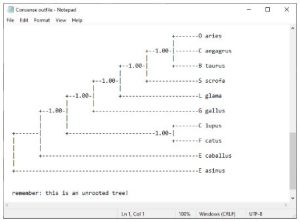31 Chapter 50: Constructing Phylogenetic Trees in PHYLIP
 s
s
In this Gr. 11 SBI3U enriched lesson covering expectations B2.1, B2.4, and B3.1, students will examine the features of 8 plastic animal toys. Using their knowledge of phylogenetics, students will define 6-8 morphological features for which to score their provided species. Once complete, students will enter their data into a Java-based phylogenetics software known as PHYLIP. Within PHYLIP, students will further manipulate their data to produce rooted, phylogenetic trees. By completing this lesson, SBI3U students will become knowledgeable in data analysis, conditional statements/events, control structures, and efficient code formatting.
Introduction
Before the event of gene sequencing technologies, taxonomy was exclusively conducted using morphological features. Briefly review the history of taxonomy with students before introducing the lesson hook. Casting students as explorers, paint a picture of a desert island full of mysterious fauna. Passing students 8 plastic toys, get students to examine their features carefully.
Working On It
Students will score 6-8 characters from their 8 species, assigning appropriate number values to various sub-characters. After noting their findings in the provided Excel spreadsheet, students will then rearrange their data to fit the PHYLIP format. Opening PHYLIP, students will input their data into Pars as detailed in the provided coding guide. Later, students can try manipulating variables within Pars to produce different results. After generating several, unrooted phylogenetic trees, students will open Consense. Inputting their data from Pars, Consense will produce a single, unrooted parsimonious phylogenetic tree. Students will then root their phylogenetic tree in FigTree, stylizing it as they see fit.
Consolidation
Students will review and reflect on their final tree. Writing creatively, students will construct a multimedia report detailing the evolutionary history of their island. Referencing important phylogenetic concepts, students will be encouraged to use appropriate scientific terminology within their group reports, presenting findings to their instructor and peers in a professional manner. Furthermore, students will write independent reflections regarding their assignment results, assessing the overall validity of their phylogenetic analysis independently.
Media Attributions
- Output Tree
